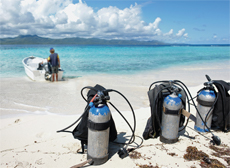




| Home | Features | Club Nights | Underwater Pics | Feedback | Non-Celebrity Diver | Events | 8 August 2025 |
| Blog | Archive | Medical FAQs | Competitions | Travel Offers | The Crew | Contact Us | MDC | LDC |

|

|
 
 |
  ISSUE 21 ARCHIVE - FLYING AND DIVINGI'm pretty sure that this will sound like a familiar setting. You are on a dive holiday, which might as well have been the best one that you've ever had. You are at an exotic, once-a-in-a-lifetime-visit location somewhere in the South Pacific. The reef is pristine and the fish abundant with all vibrant colours imaginable. There is a night dive starting at eight o'clock and you really, really want to go on it. The only snag is that your flight leaves early in the morning the next day. You are a responsible diver however and you know that if you fly too soon after diving you might suffer from the dreaded Decompression Illness.So what to do? How much time after diving is enough before you fly so that you don't feel the slings and arrows of outrageous fortune? The current advice varies greatly, with numbers thrown in – 12 hours? 24 hours? 8 hours? There are almost as many opinions on the subject as there are diving organisations. The US Navy recommends to wait for at least two hours before you board a plane after diving, the US Air Force advises that you should wait 24 hours, PADI suggests a minimum surface interval of 12 hours after a single no decompression dive and at least 18 hours before repetitive or multi- day dives, DAN recommends a minimum of 12 hours before flying, longer than that after repetitive dives, decompression dives or multiple days of diving. "Though this be madness, yet there is method in't". Let's just have a look not only at what happens but why it happens the way it does. You probably still remember the feeling when you first started diving as though all the weight of the world was on your shoulders as you were descending into the abyss. And the deeper you went, the more there was of it. This however is not just a feeling. As you go deeper, the pressure increases with 1 ATA for every 10 metres. This has a major impact on your body as the Nitrogen you absorb increases exponentially to the change in pressure. This causes the blood and the tissues to become saturated with Nitrogen. Normally we exhale this Nitrogen through the lungs as we ascend back to the surface, provided we make that ascent in a slow and controlled manner. "But ay, there is the rub". If this ascent happens too quickly, the decreased pressure causes the Nitrogen to bubble and that is what causes the various symptoms of Decompression Illness to manifest. Flying too soon after diving can put you in a similar situation to the one above, like having a rapid ascent to the surface. We are not completely clear of Nitrogen after we have finished diving but are slowly releasing it by way of exhaling it through the lungs. This amount of Nitrogen that we have is in direct correlation to the number and duration of dives that we have completed the days before. Flying too soon after diving while we still have that Nitrogen in our bodies encourages it to form bubbles and cause symptoms of Decompression Illness. It is no wonder then that divers who already have the symptoms can get worse during a flight as more Nitrogen gets released. You have to remember as well that cabin pressure in an aircraft, unless it is specifically controlled, is not exactly the same as that on the surface but equivalent to between 2000 and 8000 feet. If you have read so far I presume that: First, you are an avid diver who wants to squeeze as much diving into your holiday as is possible, and second, you want to avoid taking unnecessary risks. So based on experience, I would recommend that you give yourself a good 24 hours before flying. This becomes especially important if you have been on a live-aboard diving trip that you did several dives a day for the duration of at least a week. You may be thinking, no flight, no problem, right? Not so. There are diving destinations that can offer a variety of surface activities, like going up to the nearest mountain peak which can easily take you to a height of 10,000 feet. So this could present in itself even more of a risk than flying. And let's not forget that divers often have to cross mountain passes to get to and back from a diving site. The bottom line is that exposure to altitude, regardless of the way it happens, should be taken seriously. In case you are wondering of a better way to spend the last 24 hours of your dive trip, then soaking up the sights, sounds and food of the local culture is the natural choice. Who knows, you may fall in love with the place so much that you'll eagerly come back. And if that pint of cold lager at the bar looks so very tempting, go for it. You'll thank me later. Previous article « The Sea Doc Investigates: Coral Reefs and their Ambassadors Next article » DCI Myth Busted Back to Issue 21 Index |